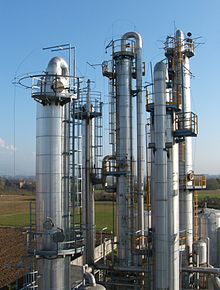Apparatus (process engineering)

In process engineering, an apparatus is a structural unit for converting substances and / or energy , whereby - in contrast to a machine - no or only minimal mechanical work is emitted or absorbed or - in contrast to a device - no or only minimal signals are processed become.
Correspondingly, most process engineering apparatus do not contain any moving, outwardly guided parts for power transmission (e.g. shafts, axles, rods), or if so, the movement of these parts is of subordinate importance for the function of the apparatus.
Apparatus is widely used in chemical engineering , biotechnology , energy engineering and other application areas in process engineering.
Apparatus types
Some of the main types of apparatus are:
General
In chemical process engineering
In thermal process engineering
In mechanical process engineering
In energy process engineering
Apparatus construction
The apparatus is the branch of engineering that deals with the design, engineering and manufacturing of equipment. In addition to precise knowledge of the process that takes place within the apparatus, knowledge of design theory , strength theory / technical mechanics , materials science , heat transfer and fluid mechanics is required. Many devices are pressure vessels and are therefore subject to increased safety requirements.